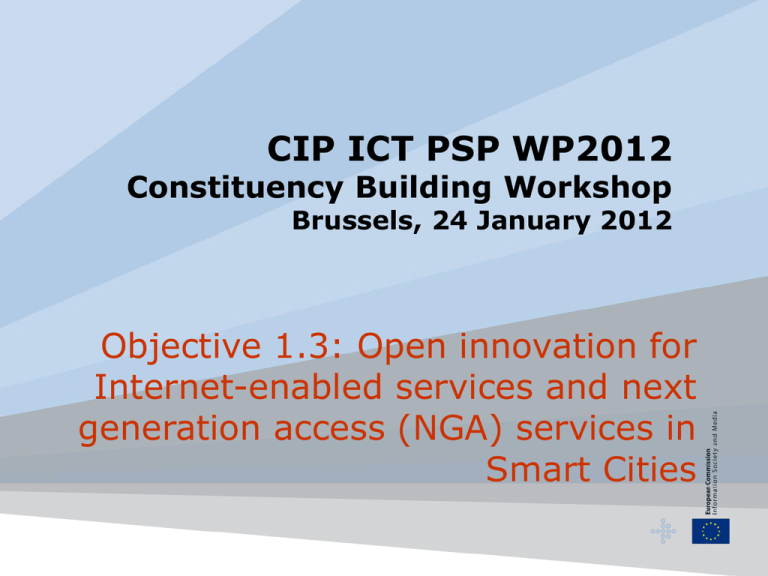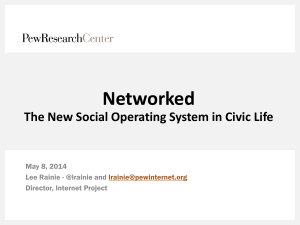CIP ICT PSP WP2012 Constituency Building Workshop
advertisement

CIP ICT PSP WP2012 Constituency Building Workshop Brussels, 24 January 2012 Objective 1.3: Open innovation for Internet-enabled services and next generation access (NGA) services in Smart Cities Quiz? INFSO D2 Networked Media Systems 2 Quiz? • The significant problems we have cannot be solved at the same level of thinking with which we created them. INFSO D2 Networked Media Systems 3 Problem statement • During the CEO Roundtable, most participants stressed that one of the barriers to NGA investment is the lack of existing or planned consumer demand for higher broadband speeds. INFSO D2 Networked Media Systems 4 Digital Agenda Scoreboard 2011 INFSO D2 Networked Media Systems 5 One possible answer • In order facilitate the development of attractive next generation content and therefore foster demand, the Commission proposes to launch an 'NGA Experiment'. INFSO D2 Networked Media Systems 6 Theme 1: ICT for Smart Cities Digital Agenda for Europe (DAE): the DAE highlights … - The importance of ICT for energy efficiency and low carbon economy - The role of ICT for smart mobility as well as the development of a new generation of web-based applications and services that leverage standards and open platforms (DAE Action 54) • DAE Action 54: expects that Member States engage in large scale pilots to test and develop innovative and interoperable solutions in areas of public interest that are financed by the CIP programme. • Total funding available for Theme 1: €27 million • • • Objective 1.1: Smart urban digital services for energy efficiency Objective 1.2: Cooperative transport systems for smart mobility Objective 1.3: Open Innovation for Internet-enabled services and next generation access (NGA) services in Smart Cities • Smart Cities = local areas that make a conscious effort to uptake innovative ICT based solutions to improve conditions of living and working and support a more inclusive and sustainable urban environment INFSO D2 Networked Media Systems 7 Objective 1.3 rationale • Observed lack of consumer demand for ultra fast Internet connections (above 30Mb/s). • Facilitate and stimulate the development of attractive services and applications, hence, fostering consumer demand. • Several pilots (Pilot Type B) to encourage a subsequent wider deployment of innovative services and applications (not yet tested on a large scale) and assess consumer response. • In addition to connected TV applications (to be tested and validated by at least one pilot), other applications may also be tested as to achieve the same goal i.e. foster consumer demand for very high bandwidth networks (NGA). INFSO D2 Networked Media Systems 8 Objective 1.3 rationale (2) • These applications may be provided over connected TV platforms, over other hardware and/or software platforms (web-based, cloud-based) or based on social networks. Some examples: – High Definition Tele-Presence or Tele-working applications (recreate the feeling of immersion and closer interaction). – Cloud computing services and applications (e.g. backup of large files, online games, streaming of media files to multiple devices). – Telemedicine and Remote Surgery services and applications. • The cumulative effect of the applications tested may also have to be taken into account. INFSO D2 Networked Media Systems 9 Objective 1.3 Open innovation for Internet-enabled services and next generation access (NGA) services in Smart Cities. Funding instrument: Pilot Type B (intended to support several pilot actions). Duration of pilots: 24-36 months, including at least a 6 months operational phase. Consortium: minimum 4 independent legal entities from 4 different EU Member States or Associated Countries. Additional requirement: at least 3 cities or regions located in different Member States or Associated Countries. • Budget: €14 million (EU contribution) for two topics: a) and b) INFSO D2 Networked Media Systems 10 Focus and outcomes (a) a) Facilitate the creation of efficient innovation ecosystems that develop services and applications making use of information generated by users (e.g. through social networks) or captured from sensors (Internet of Things). The pilots launched will complement current pilots with a view to reinforcing common strategies and methodologies, and exploiting best practices, for quick development of services through open platforms, and accelerating their adoption. The pilots are to undertake cross border testing and validation of services. INFSO D2 Networked Media Systems 11 Focus and outcomes (b) b) Stimulate demand for innovative services and applications based on next generation access (NGA) networks. • One or two pilots will be supported. At least one pilot will be funded that tests and validates sophisticated connected TV applications that are open to collaboration with third parties, with a view to promoting the early adoption of new paradigm for users and media interactions. • These connected TV applications should integrate information provided from multiple private and public sources and be tested in real life pilot conditions with supporting institutions (public and private) from different EU countries. • INFSO D2 Networked Media Systems 12 Focus and outcomes (a+b) • Applicable to both topics a) and b): • Outcomes will be achieved through large scale service demonstrations, accelerating the take-up of innovative digital services for cities or regions committed to improving living, working and environmental conditions through ICT-based solutions (i.e. Smart Cities). • Requirement: involvement of key stakeholders, such as public bodies and businesses, with strong involvement of end-users, as well as SMEs (as providers of services and applications). INFSO D2 Networked Media Systems 13 Conditions and characteristics • Applicable specifically to topic b): • The pilots need to adapt, integrate or extend existing open platforms/environments for stimulating the development of services and applications over next generation access (NGA) networks. INFSO D2 Networked Media Systems 14 Conditions and characteristics (a+b) • Applicable to both topics a) and b): • Each proposal needs to provide concrete information on: • The funding of infrastructure is beyond the scope of this objective! - functionality of the platform on which the integration will take place - services / applications that are proposed to be delivered on the platform - scale at which these services are planned to be piloted - extent to which users and citizens will be involved at all stages - value added in comparison to existing services and applications INFSO D2 Networked Media Systems 15 Conditions and characteristics (a+b) • User-centred methodologies are to be applied in order to enable the early adoption of new services or applications and reduce time-to-market. • It is expected that industrial stakeholders take-up a strong role, that SMEs with high growth potential be engaged as services and applications providers and that large user groups be involved. • Exploitation plans for the platforms and services tested during the course of the pilots need to be provided. • Dissemination and communication activities need to constitute an integral part of the proposed work. • Proposals should include specific and realistic quantitative indicators to monitor progress at different stages. INFSO D2 Networked Media Systems 16 Expected impact • Showcases of valued added and users interest for services based on NGA networks. • Establishment of common strategies, methodologies and standards for delivering user-driven, innovative Internetenabled services through open platforms with proven efficiency in accelerating the provision and wider up-take of those services. • Improved capacities for SMEs to develop, validate and rapidly scale-up new products and services through open platforms. INFSO D2 Networked Media Systems 17 Connected TV scenarios Broadcast SCENARIOS: Broadcast + Internet TV Broadcast + IPTV (managed) IPTV (managed) + Internet TV IPTV Broadcast + IPTV + Internet TV INFSO D2 Networked Media Systems 18 Internet TV Architecture INFSO D2 Networked Media Systems 19




